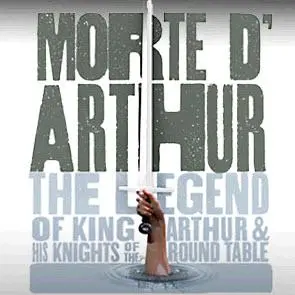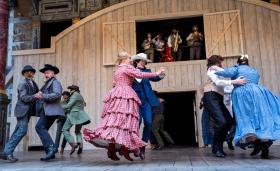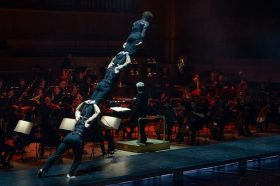Good things come in threes and three Is The Magic Number but you get more than you really need with a 3-for-2 and the RSC’s Morte d’Arthur’s three parts run at nearer four than three hours.
So large looms the Arthurian legend in our collective imagination that attempts to represent it – on cinema screens at least – often fail to live up to expectation: Sean Connery and Richard Gere’s First Knight is at least mildly amusing, in contrast to 2004’s tedious King Arthur. For my money, you have to go all the way back to 1981’s Excalibur for the blend of fantasy, swashbuckling and tragedy so central to the round table’s appeal – look out for Helen Mirren next time you watch it.
There is quite a difference in scope between knocking out a quick Camelot movie and opting to stage Thomas Malory’s 21 books of 507 chapters and 8 epic tales, enjoying a 525 year print run. It is hard to imagine any company other than the RSC having the audacity to contemplate it. Gregory Doran’s production of Mike Poulton’s adaptation ought to be compulsory viewing for ConDem ministers brandishing their own swords in the direction of the arts.
The first part of Morte d’Arthur tells of the sword in the stone, the consolidation of Arthur’s positon as King of Britain and the establishment of the round table. Forbes Masson’s cloak swirling Merlin mumbles eerie spells while setting all to rights and the whole affair is suitably stuffed with swords and sorcery.
The second segment has an episodic structure, not dissimilar to a soap opera, in which characters’ own stories are interwoven by means of a fixed social space (for Albert Square think Table Round) to which they periodically return. Sam Troughton’s excellent Arthur takes a back seat in this lively section, covering the individual knights’ tales and culminating in the quest for the Holy Grail. Special effects and stagecraft are used to the full and the faint hearted would do well to avoid the first few rows in the stalls!
The final part covers Launcelot and Guenver, the breaking of the fellowship, Gawain’s thirst for vengeance, the treachery of Mordred and Arthur’s passing into the Vale of Avalon. Unsurprisingly the last section is the longest of the three and it is played in an entirely different tone. Troughton’s Arthur is a beleaguered, broken figure whose back is bent by the weight of nostalgia: the romance of his round table is subsumed by blood feuds and the thirst for vengeance. Jonjo O’Neill’s Launcelot provides a fascinating glimpse at the chivalric code: in spite of being caught in flagrante with the Queen, he is able to ‘prove’ her innocence in battle by virtue of his skill in arms. Such a blatant contradiction seems absurd to us until we reflect that it is perfectly possible to campaign vigorously against policies in opposition, only to implement them in coalition.
There is something very familiar about the third section: fatally flawed heroes, complex web of alliances and incestuous interrelationships between warring nobility, plenty of jawing on about honour & vengeance, copious battle scenes & sieges. All the ingredients for a Shakespearian tragedy: if only he’d written a play based on Malory’s epic, it might have spared us Richard Gere.
Stratford-upon-Avon
Morte d’Arthur joins the repertoire at The Courtyard Theatre in Stratford-upon-Avon from 11 June to 28 August 2010.
Access performances
Audio described performance on 9 July
Captioned performance 10 July
Running time
The running time of Morte d’Arthur is approximately 3 hours and 45 minutes including one 20 minute interval and one 5 minute pause.
The RSC Literary Department is generously supported by THE DRUE HEINZ TRUST.
The RSC Ensemble is generously supported by THE GATSBY CHARITABLE FOUNDATION and THE KOVNER FOUNDATION.





